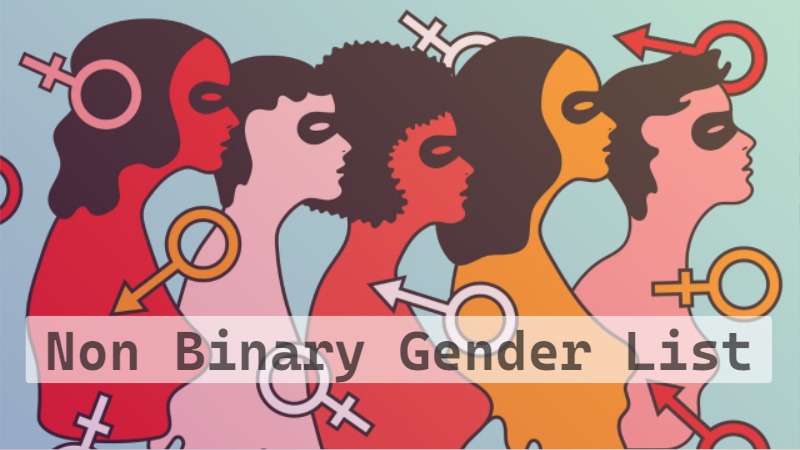
Non-binary gender is a term used to describe gender identities that do not exclusively align with the traditional categories of “male” or “female”. It is a gender identity that exists outside of the binary understanding of gender as strictly male or female, check non binary gender list here. Non-binary individuals may experience their gender as a blend of both genders, as a gender fluid or genderqueer identity, or as a completely distinct and unrelated gender identity.
Non-binary people may use a variety of pronouns, such as they/them, ze/hir, ey/em, or others, that reflect their gender identity. Some non-binary individuals may also choose to undergo medical or social transitions to align their physical appearance and societal role with their gender identity.
The non-binary is just one of many gender identities that fall under the larger umbrella of transgender and gender non-conforming identities. Gender is a complex and personal aspect of an individual’s identity, and respecting and using the pronouns and terms that people identify with is crucial in fostering inclusivity and understanding.
Non Binary Gender List
Here are some non-binary gender identities, but please note that this list is not exhaustive and new terms may continue to emerge as our understanding of gender evolves:-
- Abimegender: Associated with being profound, deep, and infinite. The term abimegender may be used alone or in combination with other genders.
- Adamas gender: A gender that is indefinable or indomitable. People identifying with this gender refuse to be categorized in any particular gender identity.
- Aerogender: Also called evaisgender, this gender identity changes according to one’s surroundings.
- Aesthetigender: Also called aesthetgender, it is a type of gender identity derived from aesthetics.
- Affectugender: This is based on the person’s mood swings or fluctuations.
- Agender: Individuals who do not identify with any gender and may describe themselves as gender-neutral or having no gender.
- Agenderflux: A person with this gender identity is mostly agender with brief shifts of belonging to other gender types.
- Alexigender: The person has a fluid gender identity between more than one type of gender although they cannot name the genders they feel fluid in.
- Aliusgender: This gender identity stands apart from existing social gender constructs. It means having a strong specific gender identity that is neither male nor female.
- Amaregender: Having a gender identity that changes depending on the person one is emotionally attached to.
- Ambigender: Having two specific gender identities simultaneously without any fluidity or fluctuations.
- Ambonec: The person identifies themselves as both man and woman and yet does not belong to either.
- Amicagender: A gender-fluid identity where a person changes their gender depending on the friends they have.
- Androgynous: Individuals whose gender presentation and identity fall outside of conventional masculine and feminine norms, often embodying a mixture of both.
- Anesigender: The person feels close to a specific type of gender despite being more comfortable in closely identifying themselves with another gender.
- Angenital: The person desires to be without any primary sexual characteristics although they do not identify themselves as genderless.
- Anogender: The gender identity fades in and out in intensity but always comes back to the same gendered feeling.
- Anongender: The person has a gender identity but does not label it or would prefer to not have a label.
- Antegender: A protean gender that can be anything but is formless and motionless.
- Anxiegender: This gender identity has anxiety as its prominent characteristic.
- Apagender: The person has apathy or a lack of feelings toward one’s gender identity.
- Apconsugender: It means knowing what are not the characteristics of gender but not knowing what are its characteristics. Thus, a person hides its primary characteristics from the individual.
- Aporagender: People who feel their gender is separate from their assigned sex and existing outside of the binary.
- Astergender / Astralgender: A gender identity that feels connected to space, stars, or celestial bodies.
- Autigender: A gender identity that is deeply connected to being autistic, with one’s experience of gender shaped by their neurodivergent identity.
- Autogender: Having a gender experience that is deeply connected and personal to oneself.
- Axigender: A gender identity that is between the two extremes of agender and any other type of gender. Both the genders are experienced one at a time without any overlapping. The two genders are described as on the opposite ends of an axis.
- Bigender: People who identify as having two distinct genders, either simultaneously or at different times.
- Biogender: Having a gender that is closely related to nature.
- Blurgender: Also called gender fuss, blurgender means having more than one gender identities that blur into each other so that no particular type of gender identity is clear.
- Boyflux: The person identifies themselves as male, but they experience varying degrees of male identity. This may range from feeling agender to completely male.
- Burstgender: Frequent bursts of intense feelings quickly move to the initial calm stage.
- Caelgender: This gender identity shares the qualities or aesthetics of outer space.
- Cassflux: There is a fluctuating intensity of irrelevance toward gender.
- Cassgender: A non-binary gender identity that feels “empty” or lacking in a defined gender.
- Cavusgender: The person feels close to one gender when depressed and to another when not depressed.
- Cendgender: The gender identity changes from one gender to its opposite.
- Ceterofluid: Although the person is a ceterogender, their identity keeps fluctuating between different genders.
- Ceterogender: It is a nonbinary gender where the person has a specific masculine, feminine or neutral feelings.
- Cisgender: Being closely related to the gender assigned at birth during the entire life.
- Cloudgender: The person’s gender cannot be comprehended or understood due to depersonalization and derealization disorder.
- Collgender: Various genders are present at the same time in the individual.
- Colorgender: In this category, colors are used to describe gender, for example, pink gender or black gender.
- Commogender: The person knows that they are not cisgender yet continues to identify as one for a while.
- Condigender: The person feels their gender only under specific circumstances.
- Deliciagender: Associated with the feeling of having multiple genders but preferring one over the other.
- Demifluid: Having multiple genders, some fluid while others are static.
- Demiflux: A combination of multiple genders with some genders static, whereas others fluctuating in intensity.
- Demigender (Demiboy/Demigirl): People who partially, but not fully, identify as male (demiboy) or female (demigirl), often feeling a connection to those genders while also having other aspects to their identity.
- Domgender: The individual has multiple genders with one dominating over the rest.
- Duragender: Having more than one gender with one lasting longer than the others.
- Egogender: It is a personal type of gender identified by the individual alone. It is based on the person’s experience within the self.
- Enby: A slang term derived from the abbreviation “NB” (non-binary), used as a casual way to refer to non-binary individuals.
- Epicene: It is associated with a strong feeling of not being able to relate to any of the two genders of the binary gender or both of the binary gender characteristics.
- Esspigender: The individual relates their gender identity with spirits.
- Exgender: The denial to identify with any gender on the gender spectrum.
- Existigender: The person’s gender identity exists only when they make conscious efforts to realize it.
- Femfluid: The person is fluid or fluctuating regarding the feminine genders.
- Femgender: A nonbinary gender identity that is feminine.
- Femme: While traditionally associated with femininity, some non-binary individuals adopt the term “femme” to describe their gender expression, regardless of their assigned sex.
- Fluidflux: A combination of “fluid” and “flux,” describing a gender identity that is both fluid and fluctuating, meaning it can change and shift in intensity.
- Gemigender: The person has two genders that are opposite yet they flux and work together.
- Gender witched: The person is inclined toward the notion of having one gender but does not know which.
- Genderblank: It is closely related to a blank space.
- Genderflow: The gender identity is fluid between infinite feelings.
- Genderfluid: People with a gender identity that is not fixed and may change or shift over time.
- Genderflux: A gender identity that can fluctuate in intensity, with feelings of being more or less connected to a certain gender over time.
- Genderfuzz: More than one gender is blurred together.
- Genderpuck: The person resists to fit in societal norms concerning genders.
- Genderpunk: A term used by individuals who challenge and resist traditional gender norms, often through their appearance, behavior, and activism.
- Genderqueer: A term used by individuals who reject traditional gender labels and identify their gender as being outside of the binary.
- Girlflux: The individual identifies themselves as a female but with varying intensities of female identities.
- Graygender: People who experience a gender that is partly outside of the binary, but with a weaker or more nebulous connection to traditional gender identities.
- Healgender: A gender identity that gives the person peace, calm, and positivity.
- Juxera: A non-binary gender identity that is characterized by intense and fluctuating feelings of gender.
- Libragender: A gender identity that is fluid and constantly shifting, often resembling the balanced scales of the Libra zodiac sign.
- Magigender: A gender identity that is closely tied to magic, mysticism, or a sense of otherworldliness.
- Masc: Similarly, some non-binary individuals use the term “masc” to describe their gender expression, irrespective of their assigned sex, to signify a more masculine-leaning presentation.
- Mirrorgender: Changing one’s gender type based on the people surrounding.
- Neutrois: A term used by some individuals who feel their gender is neutral or null, often seeking a gender-free or neutral appearance.
- Novigender: A gender identity that is new and unique, not fitting within existing gender categories.
- Omnigender: Having or experiencing all genders.
- Pangender: Individuals who identify as encompassing multiple genders and feel their gender identity is more diverse and expansive than the binary.
- Proxvir: A non-binary gender identity that is closely related to masculinity but is not exclusively male.
- Quoigender: A gender identity that is indescribable or impossible to define due to its unique and personal nature.
- Systemgender: A gender identity that is influenced by being part of a multiple or plural system, such as in the context of dissociative identity disorder.
- Third Gender: A category that exists in various cultures and societies, representing a gender identity beyond male and female.
- Two-Spirit: A term used in some Indigenous cultures in North America to describe a person who embodies both masculine and feminine qualities and may have spiritual significance within the community.
- Vapogender: A gender identity that feels insubstantial, transient, or difficult to pin down.
- Xenogender: A term for genders that cannot be easily described or understood using conventional gender terminology.
Gender is a deeply personal and individual experience, and people’s gender identities can vary widely. Remember that individuals may create new terms to better describe their personal experiences of gender. It’s important to approach these terms with an open mind and a willingness to learn and understand the unique ways people define and express their identities.
Non Binary Pronouns
Non-binary individuals may use a variety of pronouns to reflect their gender identity. Some common pronouns used by non-binary people include:
- They/Them/Theirs: This is the most widely recognized and used set of gender-neutral pronouns. For example, “They went to the store,” “That book is theirs,” etc.
- Ze/Hir/Hirs: These pronouns are another gender-neutral option. For example, “Ze is going to the park,” “I saw hir at the party,” etc.
- Ey/Em/Eirs: Another set of gender-neutral pronouns. For example, “Ey is bringing emself,” “Those are eirs.”
- Xe/Xem/Xyrs: These pronouns are also used by some non-binary individuals. For example, “Xe is busy today,” “I talked to xem yesterday,” etc.
- He/They or She/They: Some non-binary individuals may use a combination of binary pronouns along with “they/them” pronouns. For example, “He is coming over later. They wanted to hang out.”
The pronoun preferences can be highly individual, and not all non-binary people will use the same pronouns. If you’re unsure about someone’s pronouns, the best approach is to ask respectfully and use the pronouns they provide. Always strive to use the correct pronouns and show respect for individuals’ gender identities.
Non Binary Gender Identity Vs Transgender
“Non-binary” and “transgender” are related but distinct terms that describe different aspects of gender identity. Let’s break down each term:
Non-binary Gender Identity
Non-binary is a term used to describe gender identities that do not fit within the traditional binary understanding of male and female. Non-binary individuals may experience their gender as a combination of both genders, as a fluid or fluctuating identity, or as a unique and distinct gender that doesn’t align with the conventional categories. Non-binary people might use a variety of terms to describe their gender, such as genderqueer, genderfluid, agender, and more. The key point is that non-binary individuals reject the idea that gender is strictly limited to being either male or female.
Transgender
Transgender is an umbrella term that encompasses individuals whose gender identity differs from the sex they were assigned at birth. Transgender people may identify as binary (meaning they identify as exclusively male or female) or non-binary (falling outside the male-female binary). Being transgender is about the incongruence between one’s gender identity and the sex assigned at birth. This incongruence may lead some transgender individuals to pursue social, medical, or legal transitions to align their outward appearance and societal roles with their gender identity.
Non Binary Celebrities List
Check list of notable people with non-binary gender identities through the link – Non Binary Celebrities. Being non-binary refers to having a gender identity that does not fit within the binary of male and female, while being transgender refers to having a gender identity that differs from the sex assigned at birth, which can include both binary and non-binary identities. It’s important to use respectful language and honor the identities and pronouns that individuals use to describe themselves.










